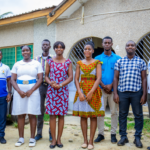Human resource for health (HRH), also known as the health workforce plays a pivotal role within the health system. They are central to the availability, accessibility, quality, effectiveness, and equity of healthcare service provision, optimum population health, and achievement of universal health coverage (UHC). To achieve the sustainable development goals (SDGs) by 2030, not just availability but the equitable distribution of well-trained, responsive, competent, motivated, and productive HRH both clinical and non-clinical is critical.
The World Health Organization (WHO) estimates a projected shortfall of 10 million health workforce by 2030 mostly in low- and lower-middle-income countries (LMICs). Around the world, many health systems struggle with workforce disequilibrium either based on a value judgement or the appropriate number of professional workforce allocation for the general population. Factors directly affecting the HRH are varied and complex. Some of these include mismatches in demand and supply, impact of health and non-health oriented policies, and the allocation of financial, physical as well as knowledge resources. Also, economic, sociodemographic, political, geographical, and cultural factors could indirectly affect the health workforce.
The Ghanaian Context
Although several initiatives within the National Health Policy and the Health Sector Medium Term Development Plan (HSMTDP 2022–2025) and its previous versions are being implemented to strengthen and make the health system more responsive whilst ensuring the attainment of UHC, the commensurate impact in terms of equitable distribution in geographical regions, levels of service and occupational groups is yet to be achieved. This is even more concerning amongst specialized groups of health professionals like doctors, , midwives, pharmacists among others.
From the 2021 Ghana health summit, several recommendations were made to attract and retain health professionals in rural areas. Steps such as scaling up the training of health workers and a draft incentive to improve the workforce salary packages, particularly in deprived areas were put forward. The 2021 Health Holistic Assessment reports that the number of doctors on the government payroll increased from 4,875 in 2020 to 5,404 in 2021 with a consistent improvement in the doctor-population ratio over the last 5years (2017-2021), which peaked at 1 doctor to 5000 population (1:5707) in 2021. This is great, however, it still falls short of the WHO standard of 1 doctor to 1000 population (1:1000) and is characterized by inequitable distribution across the regions.
Nurses and midwives no doubt, form the bulk of the health workforce, with essential roles in health promotion, emergency care service provision, primary and community healthcare, and disease prevention. A 32% rise from 44,167 in 2020 to 58,217 in 2021 was reported for the number of nurses on the government payroll with a consistent increase in nurses – population ratio between 2017-2021. The current nurses -population ratio is 1:530, going beyond the WHO recommended standard of 1:1000 and indicating that the country has excess nurses, yet the challenge of inequitable distribution remains.
Distorted geographical skill mix, the preference of highly specialized health workers to live and work in urban areas and the relegation of lower-skilled workers to rural or under-served areas results in the vicious cycle of inequity. Another issue is the inefficient health facility management evidenced by technical and equipment degradation in several health facilities. For the nursing workforce, there is little fiscal capacity to absorb the large numbers of health workers churned out annually. This has become a pervasive political issue, with graduate nurses often picketing at the ministry of health (MoH) for employment. The nursing training allowance policy was initially instituted to encourage people to take up professions in nursing. However, today, the government may be overwhelmed by the numbers as employing the large number of graduates is a challenge.
Recommendations
To achieve even distribution, urgent investments in health services such as CHPS, supply of essential medicines and basic equipment, vaccination programs, family planning services, etc. and an upgrade of existing health facilities in rural or deprived areas should be promoted to attract the health workforce. In addition, stakeholders such as community chiefs, regional leaders, and civil society organizations (CSOs) among others in deprived areas should be encouraged to sponsor qualified locals through the provision of grants or scholarships to training schools with clear legal commitments for their compulsory return to serve in the sponsor communities.
Also, a rotational system of workforce deployment could be established to ensure that all Ghanaian health professionals serve mandatorily in both urban and rural regions at various points in their professional journey. This could be criteria for attaining certain desirable career heights.
For the surplus nursing workforce, the trainee allowances policy had benefits when it was initially instituted, nonetheless, the situation has changed hence the policy should be re-evaluated. The payment of these allowances may not be sustainable in the long run. The over-politicization of policies like these is a constraint to the development of the health sector. The funds can be diverted to those willing to practice in deprived communities or to those willing to train and practice in areas that have significant gaps like midwifery, pediatric or psychiatric nursing.



